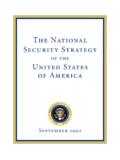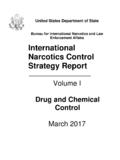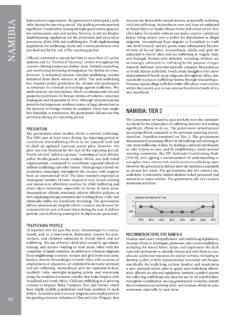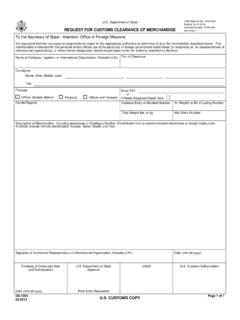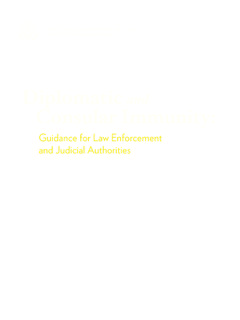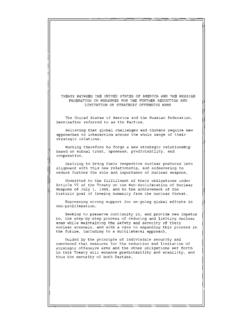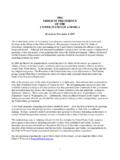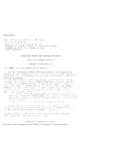Transcription of United States Strategy to - United States Department of …
1 United States Strategy to Prevent Conflict and Promote Stability ** 2020 United States Strategy to Prevent Conflict and Promote Stability This Strategy was submitted to Congress in line with Section 504(a) of the Global Fragility Act of 2079, which requires development of a ten-year Global Fragility Strategy . Table of Contents EXECUTIVE SUM MARY .. l INTRODUCTION .. 3 SECTION l: STRATEGIC CHALLENGE .. 4 SECTION 2: STRATEGIC APPROACH AND GOALS .. 6 Goals and Objectives of the Strategy .. 7 Coal 7: Prevention .. 7 Coal 2: Stabilization .. 8 Coal 3: Partnership .. 9 Coal 4: Management .. 9 SECTION 3: ADVANCING THE Strategy .. 11 Department and Agency Roles and Responsibilities .. 11 Department and Agency Decision-Making and Coordination .. 12 country and Regional Prioritization and Planning.
2 13 Compact-Style country and Regional Partnerships .. 14 International Cooperation and Public-Private Partnerships .. 14 Authorities, Staffing, and Resources .. 75 SECTION 4: STRATEGIC INTEGRATION OF United States GOVERNMENT TOOLS AND POLICY INITIATIVES .. 16 Tools .. 16 Diplomacy .. 76 Foreign Assistance .. 76 Defense Support and Security Cooperation .. 77 Trade, Investment, and Commercial Diplomacy .. 78 Sanctions and Other Financial Pressure Tools .. 78 Intelligence and Analysis .. 79 Strategic Communications .. 79 Laws and Initiatives .. 79 Women, Peace, and Security .. 20 Atrocity Early Warning .. 20 Stabilization Assistance Review .. 20 National Strategy for Counterterrorism .. 20 SECTION 5: MEASURING SUCCESS .. 21 Monitoring and Evaluation .. 21 Consultation, Learning, and Adaptation.
3 22 EXECUTIVE SUMMARY The 2017 National Security Strategy (NSS) affirms that the United States will work to strengthen fragile States ((where state weakness or failure would magnify threats to the American homeland" and "empower reform-minded governments, people, and civil society" in these places. The President affirmed this commitment when he signed the Global Fragility Act of 2019 (Title Vof , ) (GFA) into law in December 2019. This Strategy meets the law's requirement for a !(Global Fragility Strategy ." The United States Strategy to Prevent Conflict and Promote Stability seeks to break the costly cycle of fragility and promote peaceful, self-reliant nations that become economic and security partners. The United States will pursue a new approach that addresses the political drivers of fragility and supports locally driven solutions.)))
4 The United States will engage selectively based on defined metrics, host country political will, respect for democracy and human rights, defined cost-sharing, and mechanisms that promote mutual accountability with national and local actors. This Strategy outlines four goals to guide United States efforts across priority countries and regions: Prevention: The United States will establish and support capabilities to engage in peacebuilding and anticipate and prevent violent conflict before it erupts; Stabilization: The United States will support inclusive political processes to resolve ongoing violent conflicts, emphasizing meaningful participation of youth, women, and members of faith-based communities and marginalized groups, respect for human rights and environmental sustainability; Partnerships: The United States will promote burden -sharing and encourage and work with partners to create conditions for long-term regional stability and foster private sector-led growth.
5 And Management: The United States will maximize taxpayer dollars and realize more effective outcomes through better prioritization, integration, and focus on efficiency across the government and with partners. 1 The United States will achieve these goals by aligning Government operations, setting clear priorities, and integrating all tools of foreign policy: diplomacy; foreign assistance; defense support and security cooperation; trade and investment; sanctions and other financial pressure tools; intelligence and analysis; and strategic communications. The United States will recruit and train staff to work more effectively in fragile environments. The United States cannot and should not pursue these efforts alone. Accordingly, this Strategy outlines a commitment to forge new partnerships with civil society, the private sector, regional partners, and bilateral and multilateral contributors who can provide expertise and share the financial burden.
6 This Strategy prioritizes learning, data-driven analysis, diplomacy, and information-sharing to understand local dynamics, target interventions, and hold actors accountable. Jt lays out a clear process to systematically monitor policy outcomes, not just program outputs. 1f changing dynamics require alterations in approach, if programs are not showing results, or if partners are not living up to their commitments, the United States will change course. The success of this Strategy will require discipline and commitment by the whole government and our partner governments, the creation of dynamic and forward-leaning country -level strategies, and flexibly and timely resources to power change. Through this new approach, the United States will seek to avoid past mistakes and better advance America's national security interests in fragile environments.
7 2 INTRODUCTION This Strategy aims to strengthen United States efforts to break the costly cycle of fragility' and promote peaceful, self-reliant nations that become economic and security partners. It advances the aims of the 2017 National Security Strategy , which affirms that the United States will work to strengthen fragile States "where state weakness or failure would magnify threats to the American homeland" and ''empower reform-minded governments, people, and civil society" in these places. The President affirmed this commitment when he signed the Global Fragility Act of 2019 (Title V of Div. J, 116-94) (GFA) into law in December 2019. The GFA calls for the United States Government to create a unified Strategy that is intentional, cross-cutting and measurable, and harnesses the full spectrum of United States diplomacy, assistance, and engagement over a 10-year horizon.
8 The goal is to help countries move from fragility to stability and from conflict to peace. This Strategy builds upon reforms initiated by the 2018 Stabilization Assistance Review, 2018 Elie Wiesel Genocide and Atrocities Prevention Act, 2018 National Strategy for Counterterrorism, and 2019 Strategy on Women, Peace, and Security. Through this Strategy , the United States will pursue a different approach from previous efforts. Rather than externally driven nation-building, the United States will support locally driven political solutions that align with United States ' national security interests. Rather than fragmented and broad-based efforts, the United States will target the political factors that drive fragility. Rather than diffuse and open-ended efforts, the United States will engage selectively based on national interests, host-nation political progress, and defined metrics.
9 Rather than implementing a disparate set of activities, the United States will strategically integrate its policy, diplomatic, and programmatic response. The United States government will pursue reforms to use taxpayer dollars judiciously and achieve measurable results. This Strategy prioritizes data-driven analysis, diplomacy, and information-sharing to understand local dynamics, target interventions, and hold actors accountable. It requires rigorous monitoring and evaluation and periodic reviews to assess policy outcomes, not just program outputs. The Strategy also requires greater insistence on host-nation political will, defining burden-sharing, leveraging a broader range of financing tools, and holding actors accountable. The United States will modify or end programs that are not producing sufficient results or where partners are not fulfilling their commitments.
10 The United States should not address these challenges alone. The United States is committed to partnerships and burden-sharing with other nations and partners, including civil society and the private sector, to support local ownership and deliver cost-effective outcomes. In developing this Strategy , the United States Government has consulted with more than 200 civil society experts, non governmental organizations (NGOs), and bilateral partners and multilateral organizations to date. The United States Government will continue to consult stakeholders, including the Congress, as it implements this Strategy . 1 Fragility refers to a country 's or region's vulnerability to armed conflict, large-scale violence, or other instability, including an inability to manage transnational threats or other significant shocks.
